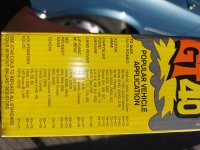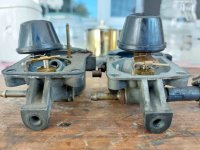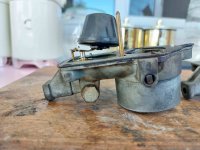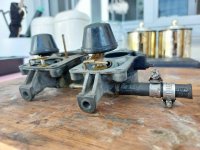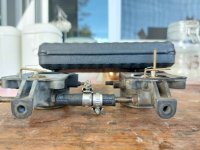I have a spare one, will try tomorrow. Fingers crossedThe coil is easy to replace....just to be sure it's not that .

You are using an out of date browser. It may not display this or other websites correctly.
You should upgrade or use an alternative browser.
You should upgrade or use an alternative browser.
504 Stalling Issue
- Thread starter James Gelido
- Start date
Avertissement James! Those of us with an interest in the outcome are following this thread closely. Bon Chance but considering how long that sat on Elizabeth's front lawn I go with the dirty fuel / tank theory. Hope you sort it ........it will make it easier to get it back to Victoria for moi!!! (When you give up.  ) I do think that Baldrick is on the money though.
) I do think that Baldrick is on the money though.
Okay, went out and got a Bosch Alternator, photo attached. She idles better and is def smoother, but alas, still stalls downhill with lights on. With lights off, does not idle as well when stopped on a slope (bonnet facing downhill) but keeps ticking. This makes me think it is not a fuel line issue. I have found that if I pull the choke on a steep downwards gradient, it stops it from stalling. Uphill, no issue.
Last edited:
No expert on 504's, but what about float level?
Have you checked float levels ?
Hi.The only thing that seems to help is if I pull the choke a bit more than halfway, the engine will idle the way it is supposed to, and does not stall! I guess the issue would be fuel starvation? It's a new fuel pump, and idles fine when on a flat, floats are good, I have tried mucking around with the mixture screw, with not much success. The revs barely change when I screw the mixture screw in or out. In fact, I've had it screwed all the way in, and the motor still ran the same as it was 5 rotations before. Any suggestions people?
My observations from reading this thread.
You mentioned that the use of some choke improves the idle. Then that would indicate a lean situation when idling.
If you have no change of idle while adjusting the idle mixture screws, then I suspect that the carburettor is not operating fully on the idle circuit. Also that the idle circuit is not able to supply enough fuel. My thought is that there may be too much other air bypassing the throttle plate(s), directly via worn throttle shaft and plate, or indirectly via other hoses on the inlet manifold or leaking gaskets? As others have said I would check and rule out these.
It would be interesting to see what a vacuum gauge plumbed to the inlet manifold indicates when idling. Ringer has previously posted a good chart to use for vacuum diagnosis.
I think you mentioned that this engine has twin carburettors? If so, are they correctly synchronised? Is the throttle idle stop at the same opening on both? Are the mixture screws non responsive on both? If so this would tend to rule out that the idle jet circuits are blocked as this would unlikely to be the same concurrently on both carburettors.
A final thought, have you done a compression test on the engine? If so, what are the cyclinder pressures at cranking speed?
I don't think I have assisted much, mainly thinking out aloud.
Cheers.
Hi.Okay, went out and got a Bosch Alternator, photo attached. She idles better and is def smoother, but alas, still stalls downhill with lights on. With lights off, does not idle as well when stopped on a slope (bonnet facing downhill) but keeps ticking. This makes me think it is not a fuel line issue. I have found that if I pull the choke on a steep downwards gradient, it stops it from stalling. Uphill, no issue.
Not sure why you replaced the alternator?
I don't consider it important electrically if the lights are on or off, or if the vehicle is on a slope. What is important is the voltage available across the battery terminals. And the voltage and current supply to the ignition system is consistent, which might be caused by problems with the wiring loom.
Have you measured the battery voltage with a volt meter (typically using a multi-meter) while the engine is idling?
Is this different from the prior alternator and the current new alternator?
A fully charged battery, that has sat for 10-15 minutes since last having the engine running, should have a voltage of 12.6 V DC. The alternator should maintain a voltage of 13.6 - 13.8 volts on a full battery while the engine is running.
Cheers.
Hi Whippet, thanks for all that info! I have just done the basics but will look into other suggestions. I recently replaced the coil, not the alternator, as to rule out any weak spark issue. It was idling rough on a level surface, but would stall on a steep gradient. Once I replaced the coil , it smoothed the idling out. Volatge is 13.2 with lights off.
I have just pulled the floats out for a second time and noticed the housing for the primary float is bent (see photos). Secondary float is straight in comparison. Will try bend this back into place and see how I go. Currently not pressing against ball bearing as required. Maybe this is causing fuel starvation on steep slope. Also, how do I go about adjusting float levels?
Cheers
I have just pulled the floats out for a second time and noticed the housing for the primary float is bent (see photos). Secondary float is straight in comparison. Will try bend this back into place and see how I go. Currently not pressing against ball bearing as required. Maybe this is causing fuel starvation on steep slope. Also, how do I go about adjusting float levels?
Cheers
Attachments
Just did, some damage to main float. Primary Float arm bent downNo expert on 504's, but what about float level?
Attachments
Last edited:
Look in the workshop manual for your car, it will also tell you what the correct level is for the floats.Hi Whippet, thanks for all that info! I have just done the basics but will look into other suggestions. I recently replaced the coil, not the alternator, as to rule out any weak spark issue. It was idling rough on a level surface, but would stall on a steep gradient. Once I replaced the coil , it smoothed the idling out. Volatge is 13.2 with lights off.
I have just pulled the floats out for a second time and noticed the housing for the primary float is bent (see photos). Secondary float is straight in comparison. Will try bend this back into place and see how I go. Currently not pressing against ball bearing as required. Maybe this is causing fuel starvation on steep slope. Also, how do I go about adjusting float levels?
Cheers
I think this may have already been covered.
Among my store of trouble shooting solutions my favourite go-to would be the idle jet. This has a minute drilling. What is the gauge of a pubic hair ? Pulling on the choke will allow you to continue. Oh, has it got an idle up solenoid* attached to the idle jet on the primary carburettor ? [Usually if air con is fitted.] These can sometimes be off again, on again in operation.
* This is a barrel like fitting with one wire attached.
Among my store of trouble shooting solutions my favourite go-to would be the idle jet. This has a minute drilling. What is the gauge of a pubic hair ? Pulling on the choke will allow you to continue. Oh, has it got an idle up solenoid* attached to the idle jet on the primary carburettor ? [Usually if air con is fitted.] These can sometimes be off again, on again in operation.
* This is a barrel like fitting with one wire attached.
Hi James Gelido.Look in the workshop manual for your car, it will also tell you what the correct level is for the floats.
For sure use your workshop manual as your reference and guide, as Col has mentioned.
You mention Primary and Secondary. I suspect that these are separate carburetters? If so, they would work in unison. Primary and secondary barrels are usually contained within a single carburettor.
1. I would assume that both the brass rods that are the hinge for the floats, should be parallel with the gasket surface of the housing. From the images it seems that one is low and the other is high.
2. From the image, there appears to be the brass tube with orifice missing from one of the housings? Where is it? Has it fallen out and is sitting in the chamber that it inserts into?
Cheers.
Hi.I recently replaced the coil, not the alternator, as to rule out any weak spark issue. It was idling rough on a level surface, but would stall on a steep gradient. Once I replaced the coil , it smoothed the idling out. Volatge is 13.2 with lights off.
Sorry about that. In post #23 you mention replacing the alternator. When I have just now clicked on the image in post #24, I see that it is a GT40 ignition coil.
If the cause of the poor idle and stalling is the ignition system, I can't think how the vehicle attitude would affect this.
Cheers.
In checking the crab floats you have found an inconsistency so work on this to start with. The floats & levels should be mirror images. Consult your manual on setting these up correctly before going any further. If these are true identical carbs then throttle butterflies must be set up identical too. If not , as in the 604 set up of primary & secondary carbs , then the settings of the butterflies will be different & critical. Once again refer to the manual for setting them properly.
I wish you luck & keep having fun !
I wish you luck & keep having fun !
Sounds like float levels. I had neglected to notice it had the dreaded double carbies. But I think the coil output just made it worse.
We had an American member here a few years ago who went through a bit of drama getting his double carbies repaired and tuned.
He didn't want to convert to single carby, or perhaps it was difficult to get one there in the US. Anyone remember his name ? It could be interesting to look up his posts on the subject.
We had an American member here a few years ago who went through a bit of drama getting his double carbies repaired and tuned.
He didn't want to convert to single carby, or perhaps it was difficult to get one there in the US. Anyone remember his name ? It could be interesting to look up his posts on the subject.
OR.... get an inlet manifold from a pre 1976 504 and put either a Weber or a Solex 2 barrel carby onto it. Smoother and easier to tune and goes better if you can't get your present setup to work. That twin carby setup post 76 is a pain.
No luck I'm afraid fellas. Same issue, lights on, revs drop, car stalls. Goes okay with lights on. I did replace the alternator to a 80A instead of 60A when I first received the car, would this make any difference? I might change the setup as Neil has suggested. Did wan;t to keep it as close to stock as possible, but this is becoming a real pain in the rear end.
Thanks for your suggestions mate! I appreciate them. Separate carbies, yep. Adjusted both rods/arms to manual specs, not much change I'm afraid. No orifice in primary carbie, only secondary, which is how I received it. Nothing seems top have dropped off either. I assume that is how it comes?Hi James Gelido.
For sure use your workshop manual as your reference and guide, as Col has mentioned.
You mention Primary and Secondary. I suspect that these are separate carburetters? If so, they would work in unison. Primary and secondary barrels are usually contained within a single carburettor.
1. I would assume that both the brass rods that are the hinge for the floats, should be parallel with the gasket surface of the housing. From the images it seems that one is low and the other is high.
2. From the image, there appears to be the brass tube with orifice missing from one of the housings? Where is it? Has it fallen out and is sitting in the chamber that it inserts into?
Cheers.
As in whippets post 33 the float pivot rods should be parallel to carry top gasket face otherwise floats will pivot through an arc and may stick/jam in fuel bowl.also on electrical side does it have a good earth wire body to engine?usually a cable from bell housing l/hand dust cover upper mount bolt to chassis/body,if no cable body to engine then can result in electrical breakdown under load,usually when starting or with lights,heater fan and other items on…jim
